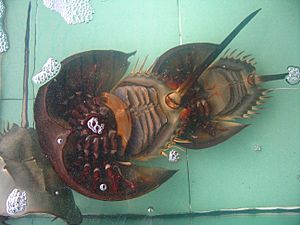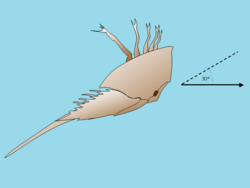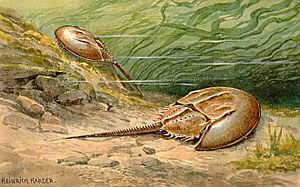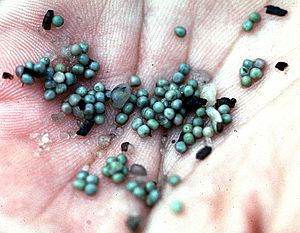Horseshoe crab facts for kids
Quick facts for kids Limulidae |
|
|---|---|
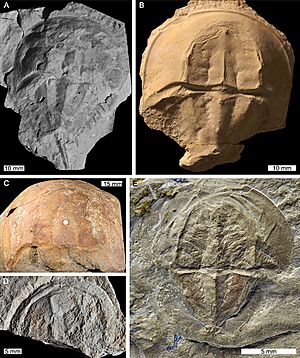 |
|
| Jurassic-aged limulids. Crenatolimulus (A,B), Limulus (C), Mesolimulus (D,E) | |
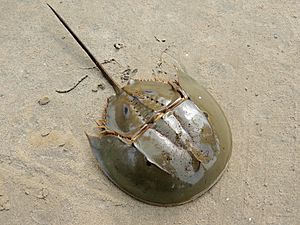 |
|
| Tachypleus gigas, one of the four extant species | |
| Scientific classification |
|
| Kingdom: | Animalia |
| Phylum: | Arthropoda |
| Subphylum: | Chelicerata |
| Order: | Xiphosura |
| Superfamily: | Limuloidea |
| Family: | Limulidae Leach, 1819 |
| Genera | |
|
See text |
|
Horseshoe crabs are amazing sea animals. They live in salty ocean water and sometimes in water that's a little salty. Even though they are called "crabs," they are not true crabs. They are actually arthropods, like insects or spiders.
Horseshoe crabs are more closely related to spiders, ticks, and scorpions. They belong to a group called chelicerates. They mostly live in shallow coastal areas. You can find them on soft, sandy, or muddy ocean bottoms.
People in some parts of Asia eat horseshoe crabs. They are also used as bait for fishing and in fertilizer. Scientists use their blood for important medical tests. Sadly, the number of horseshoe crabs has been going down. This is because their homes are being destroyed and too many are being caught. One type of horseshoe crab, Carcinoscorpius rotundicauda, might have a toxin called Tetrodotoxin.
Horseshoe crabs have been around for a very long time. Their oldest fossils are over 440 million years old! This means they lived during the Ordovician period. The modern types of horseshoe crabs appeared about 250 million years ago. Because they have changed so little over millions of years, they are often called "living fossils".
Contents
What are Horseshoe Crabs?
The family name for horseshoe crabs, Limulidae, comes from the word limulus. This Latin word means "a little askew."
Horseshoe crabs look a bit like crustaceans, but they are in a different group of arthropods called Chelicerata. They are related to extinct animals called eurypterids, or "sea scorpions." Some of these sea scorpions were the biggest arthropods ever! The earliest horseshoe crab fossils are from about 480 million years ago.
Body Parts and How They Work
A horseshoe crab's whole body is covered by a hard shell called a carapace. They have two large compound eyes on the sides of their head. Each of these eyes has about 1,000 tiny lenses. They also have a pair of middle eyes that can see both regular light and ultraviolet light.
They have other smaller eyes too: one on top, and two tiny ones near their mouth. They even have light sensors on their tail, called a telson. Even though they have many eyes, their eyesight isn't great. But their eyes are super sensitive to light at night!
Horseshoe crabs use small claws called chelicerae to move food into their mouth. They have five more pairs of legs for walking. The first pair are called pedipalps. Their mouth is in the middle of their legs. The bases of their legs act like jaws to help them grind food.
Male horseshoe crabs have special pedipalps that look like boxing gloves. They use these to hold onto the female during mating. The last pair of legs helps them push off the ocean floor when they walk. If a horseshoe crab loses a leg or its tail, it can slowly grow back! Cracks in their shell can also heal.
Behind their legs, horseshoe crabs have special structures called book gills. These gills help them breathe underwater. They also use their gills to swim sometimes. Unlike us, they don't have bones inside their bodies. But they do have some cartilage that supports their gills.
How Horseshoe Crabs Grow
Female horseshoe crabs are usually 20–30% larger than males. The smallest species is C. rotundicauda, and the largest is T. tridentatus. A male C. rotundicauda is about 30 centimeters (12 inches) long, including its tail. Its main body shell is about 15 centimeters (6 inches) wide.
The largest species, T. tridentatus, can be up to 79.5 centimeters (31 inches) long, including its tail. It can weigh up to 4 kilograms (9 pounds). Young horseshoe crabs grow about 33% bigger each time they molt (shed their old shell). They keep molting until they reach their adult size.
What Horseshoe Crabs Eat
Horseshoe crabs usually search the ocean floor for food. Their main diet includes worms and molluscs (like clams or snails). They might also eat small crustaceans or even tiny fish.
Horseshoe Crab Reproduction
During their breeding season, horseshoe crabs move to shallow coastal waters. In the northeastern U.S., this is in spring and summer. In warmer places, they breed all year. The smaller male horseshoe crab holds onto the back of the larger female. He fertilizes the eggs as she lays them in the sand.
Other males, called "satellite males," might gather around the pair. They can also help fertilize some eggs. You can tell young female horseshoe crabs apart because they don't have mating scars.
A female can lay between 60,000 and 120,000 eggs. She lays them in groups of a few thousand at a time. The eggs hatch in about two weeks. Many eggs are eaten by shore birds before they hatch. Young horseshoe crabs molt six times in their first year. After that, they molt once a year for 3 or 4 years.
It has been hard to breed horseshoe crabs in captivity. Some scientists think mating only happens where the eggs originally hatched. They are not sure what in the sand makes this happen. However, scientists have been able to help them breed using special methods.
To help horseshoe crabs, a breeding center was built in Johor, Malaysia. Crabs are bred there and then released into the ocean. It takes about 12 years for them to grow big enough for people to eat.
Horseshoe Crabs and People
Blood Harvesting
Horseshoe crabs have blue blood! This is because their blood uses a copper-based substance called hemocyanin to carry oxygen. Our blood uses iron, which makes it red. Their blood also has special cells called amebocytes. These cells act like our white blood cells, fighting off germs.
Amebocytes from the blood of L. polyphemus are used to make a substance called LAL. LAL is very important in medicine. It helps detect harmful bacteria in medical tools and vaccines. Because of this, there is a high demand for their blood.
To get the blood, horseshoe crabs are collected, their blood is taken, and then they are released back into the sea. Most of them survive this process. However, some do not. The more blood taken, and the more stress they have, the less likely they are to survive. About 500,000 horseshoe crabs are collected each year for their blood.
Taking blood can also stop female horseshoe crabs from laying eggs. Or it can reduce the number of eggs they lay. Up to 30% of a crab's blood is removed. They are kept out of the ocean for one to three days. They can survive on land for up to four days if their gills stay wet. Some scientists worry that not all companies return the crabs to the ocean. They suspect some might sell them as fishing bait instead.
The use of horseshoe crab blood in medicine is slowly changing. In 1986, scientists found a way to make a similar test using a substance called rFC. This rFC can be made in a lab. In 2003, a synthetic version of rFC became available. At first, companies were not very interested. But now, more companies are making rFC. Also, European regulators have approved its use. This means that soon, we might not need to harvest blood from horseshoe crabs as much.
In 2019, the United States Senate asked the Food and Drug Administration to look into other ways to test for bacteria. Groups like PETA supported this. However, in 2020, the U.S. Pharmacopeia did not give rFC the same official status as horseshoe crab blood. This makes it harder for U.S. companies to use rFC.
The need for new vaccines, especially during the COVID-19 pandemic, has put more pressure on American horseshoe crabs.
Fishing Use
Horseshoe crabs are used as bait for catching eels and whelk (a type of sea snail). Nearly 1 million crabs are caught each year in the United States for bait. This is much more than are used for medical purposes.
However, some areas have banned or limited horseshoe crab fishing. For example, New Jersey banned it in 2008. This was to protect the red knot, a shorebird that eats horseshoe crab eggs. Delaware only allows male crabs to be caught. South Carolina has a permanent ban.
A low number of horseshoe crabs in Delaware Bay could harm the red knot bird. Red knots are migratory birds that fly long distances. They stop on the beaches of New Jersey and Delaware to eat the protein-rich horseshoe crab eggs. Efforts are being made to manage horseshoe crab fishing to protect these birds.
Culinary Use
The number of T. gigas horseshoe crabs in Indonesia and Malaysia has dropped a lot. These crabs are often caught to supply Thailand, where the female crabs are a local food. Catching mostly females has led to an unbalanced number of males and females in the wild. This also causes their population to decline.
Protecting Horseshoe Crabs
Building along shorelines is dangerous for horseshoe crabs. It limits the places where they can lay their eggs. Walls built along the coast can also block their access to these important areas.
Because of habitat loss, shoreline building, use in fishing, plastic pollution, and being eaten as food, horseshoe crabs are facing serious threats. One species, T. tridentatus, has already disappeared from an area in Taiwan. With more than a 90% drop in young T. tridentatus crabs, it is feared that Hong Kong might be next to lose them. This species is listed as endangered on the IUCN Red List. This means it is at high risk of extinction due to being overfished and losing its critical habitat.
See also
 In Spanish: Cangrejos herradura para niños
In Spanish: Cangrejos herradura para niños


